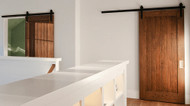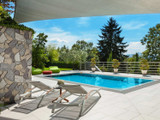
Installing a barn door and sliding hardware yourself can seem daunting, but it’s actually straightforward! However, there are a few essential things to keep in mind, so your installation goes smoothly.
Here is a list of 10 common mistakes that you should avoid when shopping for a barn door:
- Measuring Incorrectly
- Not Considering Privacy
- Going Without a Barn Door Floor Guide
- Not Protecting Wood Finishes
- Selecting the Wrong Hardware for Your Door Weight
- Choosing a Low-Quality Metal for Hardware
- Forgetting a Soft Stop in Quiet Spaces
- Not Using a Track Support Header Board
- Damaging Your Drywall
- Using the Wrong Cleaner
MISTAKE 1: Measuring Incorrectly
Measuring for a barn door is different than for a swinging door. You will need a different size for a sliding door versus a swinging door in the same size opening.
So, how do you measure for a barn door?
Start by measuring from the highest point on the floor (in case it is not level) to the top of the door frame. Most standard interior doorways will be 80” tall. If you have a casing/trim around the frame, measure to the casing’s outside edge, not the top of the doorway opening. Whatever your final measurement is, add one inch to get your ideal barn door height.
To find out how wide should your barn door be, measure from one side of the doorway to the other. Again, measure to the outside edges of the door casing. Most standard interior doorways are 36” wide. Add two inches to your width measurement, and now you have your ideal barn door height and width. Why add additional inches to your barn door? That brings us to our next topic.


MISTAKE 2: Not Considering Privacy
Many people like the idea of adding a sliding barn door to a bathroom or another smaller room. But they may not ask the vital question: Is a barn door private enough for a bathroom? The answer is yes, but it depends on how it is installed and the materials used. Solid wood is better at soundproofing than a hollow-core door, and the thicker the door, the better. But one of the most important things that will make barn doors more private is making the door overlap the opening. We recommend adding at least 1” overlap on each side, but 2” is even better. The more overlap you have, the less light and sound come through. You can also add high-quality weather stripping to the door casing, if you have an offset, to make the sliding door extra snug against the opening when closed. A brush sweep along the bottom can also help soundproof a sliding barn door.
There are also sliding barn door locks, like a teardrop lock or a hook and eye latch, that will help make a barn door more private.
MISTAKE 3: Going Without a Barn Door Floor Guide
It may seem like a minor detail, but it’s a crucial component of your barn door installation: a sliding door guide. These small accessories are typically floor-mounted and keep the door from hitting the wall, and prevent the frustrating swaying back and forth on the track every time you slide it open.

We highly recommend using a C-guide. They keep the door gliding smoothly by hugging the bottom. Installation is easy as they simply screw into your floor and do not require cutting the door. There are fixed sizes, or an adjustable option (available by calling customer service) for uncommon thicknesses so you can get an exact fit.
The most cost-effective type of guide is a T-guide made of a strong polymer material that is mounted on the floor. It requires a groove cut into the bottom of the door.
Lastly, if you don’t want to drill your floor or are on a concrete slab, you can use a wall-mounted sliding door guide. It slides under and around the door and is attached to the wall. As the door slides, a wheel rolls it along to keep it positioned correctly. All of these options do the same thing - it is up to you to choose the guide that works best for your application. Just don’t go without one!
MISTAKE 4: Not Protecting Wood Finishes
One of the most common problems we see with barn doors is warping, twisting, and cupping because the door was not sealed with a finish. Sliding barn doors are particularly susceptible to warping since they have one central point of contact where the hangers attach to the doorway, unlike swinging doors that have hinges to provide support from top to bottom.

A finish not only protects the door from reacting to moisture and temperature changes in the environment, but will bring out the true color of the wood and enhance the rich detail in the grain patterns that you wouldn’t see otherwise. You can see sample tiles in our wood species guide that we finished on one half and left the other half raw. It’s a pretty incredible difference! As a bonus, finishes can also provide UV protection for doors that may be exposed to direct sunlight.
MISTAKE 5: Selecting the Wrong Hardware for Your Door Weight
Different styles of hanging hardware can bear different loads. If you have a door made of a dense, heavy wood, or an oversized door with glass or metal panels, there are some styles you’ll want to avoid. If you’re looking for barn door hardware for a heavy door, you’ll want a style that wraps over the door and straps to the front of it, like our classic style that is rated for up to 400 pounds. Avoid any style that is a top-mount only, like the aero kit or our modern architectural style, because these hardware styles will not have enough strength to carry more than 150 pounds safely. If you’ve got an exceptionally heavy or oversize door, look for an industrial barn door hardware option that can carry up to 800 pounds. Our customer service team is ready to help you choose the right style for your door and has access to many styles not featured on our website.
MISTAKE 6: Choosing a Low-Quality Metal
There are several options for different metals you can choose for your barn door hardware. So what makes the best barn door hardware? The majority of hardware kits on the market right now are made of aluminum. This means that the hardware costs less, but it is on the lower end of the quality scale. If you need hardware that will last a long time, avoid aluminum hardware.
Steel is a sturdier option, but there are a few different types of finishes with steel. Raw steel hardware is a great choice for someone who wants their hardware to be strong but have a worn-in look. Over time, raw steel oxidizes and starts to show rust spots. This effect looks fantastic in an industrial or shabby chic decor setting. Just be aware of how the hardware will change in appearance if you go for this option. Suppose you need something truly industrial that will not wear down as fast as raw steel. In that case, hot-dipped galvanized steel sliding hardware is a solid choice that works well in outdoor settings and can stand up to corrosive environments better than any other metal.
If you are looking for a specific barn door hardware color, make sure it’s powder-coated. Powder-coated colors are significantly more durable than the alternative - painted steel. Steel that is simply painted (often spray-painted) will not hold up to the test of time like powder-coats that are baked on the metal and result in a thick, dense layer of color.
Stainless steel is another excellent option for barn door hardware kits. Not only does it make for luxe and modern barn door hardware, but it is also incredibly sturdy, and the finish stays smooth and spotless with little attention needed.
And if you need something chic and on-trend, you can even choose a specialty metal like solid brass barn door hardware, or gold, silver, or copper powder-coated steel metallic tones.

No matter what metal you choose, be aware of the maintenance involved and the environment you are using it in. The only metals suitable for salty air, for instance, are galvanized and stainless steel (and even then, performance depends on just how much exposure the hardware is getting.) Brass is a softer metal, so don’t install it in place where it is likely to be nicked or scratched. Brass also oxidizes unless you continually treat it with brass polish. Even sturdy stainless steel could use a polish from time to time.
MISTAKE 7: Forgetting a Soft Stop in Quiet Spaces

A noise-dampening component to a flat track hardware kit is a soft stop. A soft stop grabs the door and eases it gently to the end of the track before it slams into the end stop. If your track is long enough (6 feet or longer), you can add a soft stop to each end of the track so the door will close quietly, whichever direction it is pushed. A soft stop makes it impossible to slam the door.
If you’re wondering how to make a barn door quieter, a combination of a soft stop and hush wheels will work wonders.
MISTAKE 8: Not Using a Track Support Header Board

A support board is not always necessary, but it will almost always make your installation so much easier. Sometimes called support headers, barn door backer boards, barn door header boards, or flat track header boards; these boards give you the structural support you need and allow you to install the track to the board, which is often easier than trying to align the exact hole placement in the track with the studs in the wall. A ledger board adds a bit of an offset to the door, which is good for doorways with protruding casings.
MISTAKE 9: Damaging Your Drywall
If you are not using a ledger board in your installation, you will need to be careful not to crush the drywall.

By drilling a shallow 1.25” diameter hole where the bolts will be mounted, you can insert a drywall anti-crush ring and install your hardware. By using these simple little rings, you can save yourself a lot of headaches trying to repair crumbling drywall.
MISTAKE 10: Using the Wrong Cleaner
A barn wood door will need a wipe down from time to time. A duster usually works well, but on the occasion that you need more than that, make sure not to use harsh chemicals. For hardware, you can use a damp cloth to wipe down powder-coated or raw steel. After you wipe it down, use a dry cloth to absorb any moisture. You don’t want to leave any water on the hardware. Stainless steel needs to be cleaned with a formula made specifically for stainless steel; otherwise it will streak. Wipe in the same direction as the brushed pattern. The same goes for brass - do not use water, soap, or any cleaner other than a brass polish. Always use a soft cloth such as microfiber - not paper towels or shop rags. Brass is the softest of all barn door metals, so take extra care to clean it gently.
To clean wood doors with a finish, a slightly damp rag will do the trick. Don’t use soaps or oil-based cleaners; they can damage the finish. The finish is there to protect the door, so deep cleaning and polishing aren’t necessary. An occasional dusting is all your door needs.

For reclaimed, and weathered wood, don’t use a cloth to wipe it down. Instead, use a very soft brush vacuum attachment to pull the dust out of crevices. Do not rub with the door with the attachment; just gently graze the surface enough to pick up any dust that is clinging to the surface. You can also use canned air to blow debris out. If you use a cloth, the fibers can get caught on the wood’s raw, weathered edges. It could also cause splintering if the fabric gets lodged under a piece of the wood as you are wiping it. Raw wood should never get wet or be cleaned with any type of cleaner.
Shop Related Products


